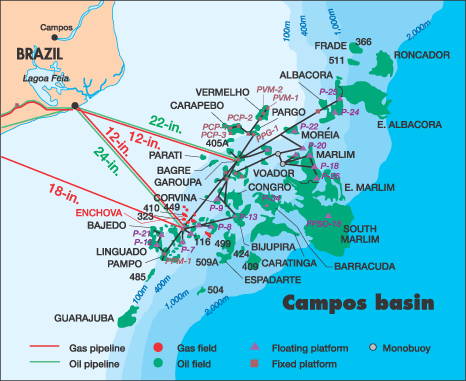South America: Brazil
Aug. 2001 Vol. 222 No. 8 International Outlook SOUTH AMERICA Stuart Wilkinson, Contributing Editor Brazil The Brazilian economy started to feel th
SOUTH AMERICAStuart Wilkinson, Contributing Editor BrazilThe Brazilian economy started to feel the effects of Argentina’s financial crisis late last year. The national currency, the real, was under pressure, and growth estimates for this year were reduced, due to increased oil prices and financial-market volatility. By second-quarter 2001, the country was facing an electricity shortage, due to low water levels in hydroelectric dams. Electricity rationing could cut 1.5% off GDP growth this year. Further, the real set a record low compared to the dollar, depreciating 30% in the first six months of 2001. The government started selling shares in 24.21% of Petrobrás, opening the company to private capital investments. About 250,000 Brazilians bought shares. Called "popular capitalism," it was seen as a great success.
Exploration. The third round of tenders was completed in June and resulted in awarding 34 of the 53 blocks offered, netting the government $240 million. Petrobrás was again the major winner, as in the previous two rounds. Further rounds will be held annually. At least 30 oil fields have been discovered in Campos basin, with seven deepwater fields holding more than 100 million bbl of oil reserves, each. The ANP says that Campos basin fields collectively hold recoverable oil / condensate reserves of 7 to 8 billion bbl. Shell reportedly hit pay last September on Block BM-C-10 with its 1SHELL-1-ESS well, but the company did not release any details. A month later, Petrobrás struck gas with its 1-BRSA-14-BAS well. The well was drilled in Block BCAM-40 in Camamu basin and might have discovered a 700-Bcfg reservoir. In November, Amerada Hess found oil and gas on Block BS-2, while Petrobrás hit oil last December drilling in 7,359-ft water in Campos basin. The latter discovery tested 3,000 bpd of 35°-API oil. El Paso, Petrobrás, Devon Energy, Repsol-YPF, TotalFinaElf and BG, as operators of their respective blocks, all had discoveries within the past year. Several wildcats are drilling ahead, and more discoveries are expected.
Drilling / development. Wells drilled rose 55% last year and should maintain that level this year. A number of offshore field development projects are underway. Last September, Petrobrás acquired partners for development of Campos de Coral and Estrela do Mar fields in Block S-3 in Santos basin. Brazilian Queiroz Galvao has a 30% stake, Coplex has 27.5% and Starfish has 7.5%. Total investment in the fields is about $76 million, with production starting in September 2001 and estimated to peak at 16,000 bopd. Enterprise Oil plans to drill 16 development wells as part of the Bijupirá-Salema field development project, which began in mid-2001 and lasts two years. Petrobrás will spend $170 million for development of Albacora field in the Campos basin. As Albacora Phase II is completed, the field’s output will rise to 150,000 bopd from 50,000 bopd. In January 2001, Petrobrás received two more vessels, the P-40 floating production platform and the P-38 FPSO, for Marlim Sul field development. The P-40 can process up to 150,000 bopd and export a maximum of 212 MMcfgd. The first of four modules should go onstream in July 2001. When development is complete, Marlim Sul should hit peak output of 360,000 bopd by 2007. At mid-2000, Petrobrás associated with Potiguar and Unopaso, subsidiaries of Unocal and El Paso Energy, respectively, for E&P operations in Rio Grande do Norte state. Two areas – together comprising 148 sq mi (384 sq km) – were to be exploited. One block has produced since May 1999, while the other is for exploration. In the producing lease, investments totaling $170 million were foreseen, including installation of six platforms and 71 mi (114 km) of pipeline. Production. In March of this year, the biggest floating oil platform in the world, the 33,000-t P-36 sank in 4,488 ft (1,368 m) of water, 75 mi (120 km) off the coast of Rio de Janeiro state in Roncador field. Petrobrás expects to continue raising oil production until Brazil becomes self-sufficient, hopefully by 2005. Oil-production targets call for an increase to 1.39 million bopd by year-end. The output target for 2002 is 1.52 million bopd. There were 6,285 wells producing 1.46 million bopd last
year, including condensate. Gas production was 1.3 Bcfgd. Estimated reserves of crude and condensate were 8.47
billion bbl, and there were 7.8 Tcf of gas reserves. |
|||||||||||||||||||||||||||||||||||||||||||||||||||||||||||||||||||||||||||||||||||||||||||||||||||||||||||||||||||||||||||||||||||||||||||||||||||||||||||||||||||||||||||||||||||||||||||||||||||||||||||||||||||||||||||||||||||||||||||||||||||||||||||||||||||||||||||||||||||||||||||||||||||||||||||||||||||||||||||||||||||||||||||||||||||||||||||||||||||||



